Video marketing is not a “nice-to-have” marketing strategy anymore. It has become a digital marketing necessity for almost every business – from financial planners to physicians.
If you haven’t jumped into the video-making pool yet, now is the time to take that plunge.
Why?
People love to watch videos. No matter what type of business you have, videos can help you sell more products or services. And if you think that video marketing doesn’t fit your industry, it’s time to put your creative mind to work.
For example, if you’re a plumber and you post videos on simple plumbing hacks that people can use to solve their minor plumbing issues, what plumbing company do you think they will call when they have a big plumbing problem? Yup. You! (See how that works?)
And you’ll find that many YouTubers are die-hard fans. They’re watching all sorts of videos about how to jimmy a locked door, make the perfect smash burger, and everything in between.
You can find a video about how to do almost anything on YouTube. And if you look, you’ll find that most of these videos are tied to some type of business – like a locksmith or a burger joint.

So if you want people to watch your videos and take action – whether it’s to look at more videos on your YouTube channel or to go to a link that’s in your video’s description – you need to get people to your video.
That means you need to attract YouTube’s algorithm to your video.
Like Google’s algorithm, YouTube’s algorithm comprises hundreds of factors that determine a video’s ranking position.
But just like a search on Google, everything starts with words – keywords and keyword phrases.
To get your video found on YouTube, you need to master finding the right keywords to target for your video and then put those keywords strategically where they need to go.
How to do your YouTube keyword research
Keywords are an important ranking factor for YouTube videos.
Similar to Google’s search engine, YouTube wants to show people the most relevant videos according to the keywords or keyword phrases people are searching for.
When doing keyword research for YouTube, you want to find keywords that will drive traffic to your video – phrases that people are searching for frequently.
One of the best (and free) places to look for keywords is YouTube itself.
When you’re on YouTube and start a search, YouTube will offer up “search predictions.” These are keyword phrases that people on YouTube are actually searching for.
If you’re on a tight budget, this is a great way to find some keywords as a starting point! (It’s also a good way to get video content ideas.)
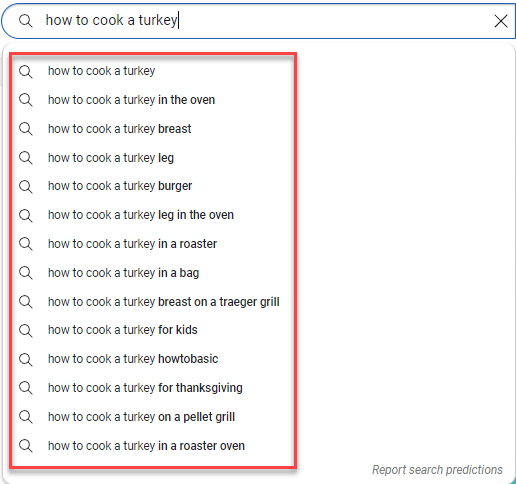
But if you’re serious about ranking your videos on YouTube, you should use paid keyword research tools (like Semrush, SE Ranking, Moz or others.)
These types of tools will give you more robust information about the keywords so you can be more strategic about the keywords you’re targeting.
Let’s take a look at SE Ranking as an example. This is a traditional SEO software tool, but we can still glean some great insights on what types of keywords we should focus on for our YouTube videos.
For instance, when we enter “how to unclog a kitchen sink” as a keyword phrase, we will get keyword ideas and semantically related keyword phrases.
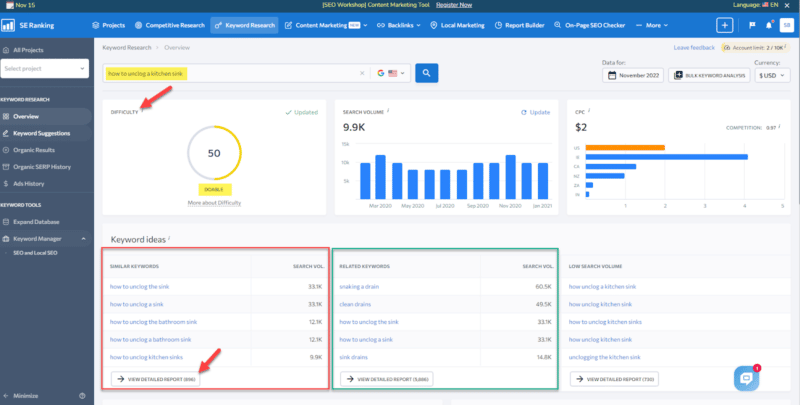
When you click on View detailed report, you’ll see a ton of information about each of the keyword phrases.
Even though this info is related to Google search, you can still extrapolate it and use it for YouTube.
One important thing to look for in this view is videos that appear in the SERP features.

You can see live results or copy to the clipboard and paste the SERP results in a new window to see what types of videos appear in Google search results.
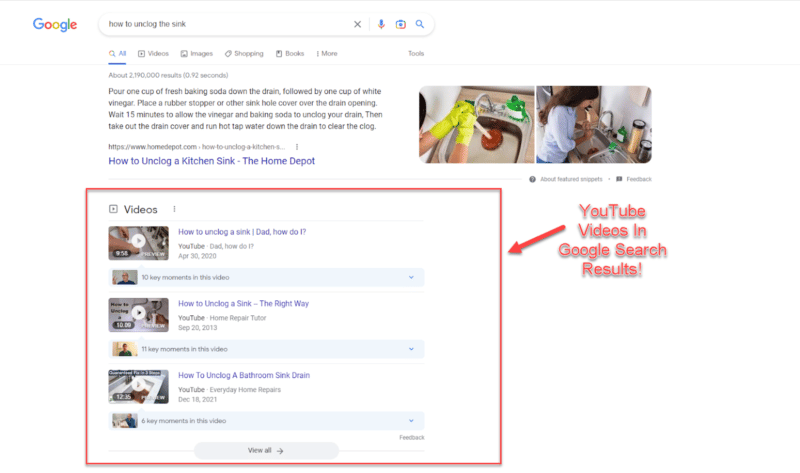
If videos show up on the first page of Google, then those are great keywords to target. (If you check out the videos on the SERPs, more than likely they are YouTube videos.)
These are perfect keywords for optimizing your YouTube videos because you know that Google is already showing videos in search results.
Not only can you rank your videos on YouTube, but you also have a chance of getting your videos to show up on Google search results.
Now all you have to do is make your video better and more informative than your competitors and optimize your YouTube video options more strategically to (hopefully) take over their spots in the Google SERPs.
Using traditional SEO tools can make your keyword research for YouTube life a lot easier.
Use YouTube SEO tools to find the right keywords for your video optimization
If you want to find the right keywords for YouTube videos, try out some tools specifically created for YouTube marketing.
Keyword Search
You can discover keywords using Keyword Search’s “AI algorithm,” developed by a top YouTube marketing expert.
The tool:
- Bases all its data directly on YouTube search results from the user’s perspective.
- Scrapes and analyzes YouTube data to help you find the best keywords to use when optimizing your videos on YouTube.
And because your top-ranking rivals often know something you don’t, you can even conduct “Competitor Research” on their keywords, rankings, YouTube channels and videos.
This lets you better develop your video marketing content strategy and plan which keywords you’ll target.
You can also use the tool’s “Collections” feature to keep track of all your keywords, videos and the competitors you’re tracking.
At its most basic level, using Keyword Search is as easy as entering a keyword phrase in the search field:
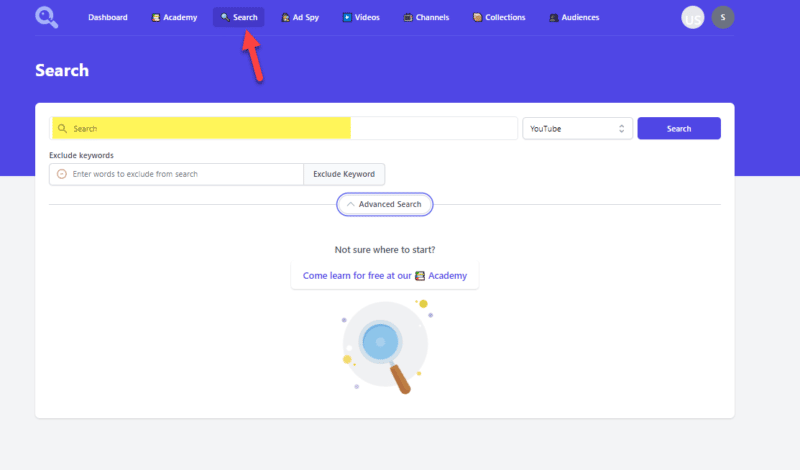
You’ll then get a slew of keyword phrases to review and see the average monthly search volume on YouTube for each keyword.
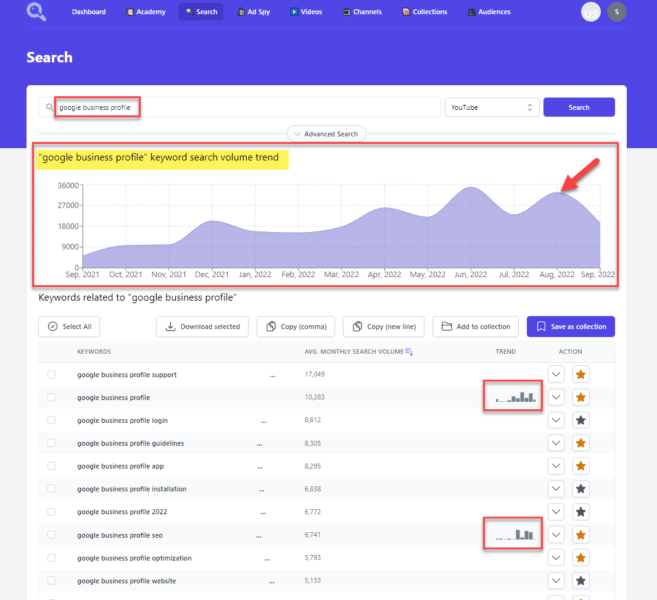
As you’re analyzing the keyword results you get, if you see keywords with “trends,” click on the down arrow to see the trends in detail – the high and low points.
As you’re analyzing the keyword results you get, if you see keywords with “trends,” click on the down arrow to see the trends in detail – the high and low points.

If you spot a hot and trending topic over the past month (or now), get behind your camera, do a video, and optimize for those trending keyword phrases.
Creating and optimizing a video for a trending topic will boost the chances of your video getting searched for and found on YouTube!
To get some semantic keywords to target, Keyword Search also uses its algorithm to give you similar keywords.
These are additional words to consider optimizing your videos for. You can see:
- How similar the word is to your original search query.
- The average search volume.
- Trends, if any.
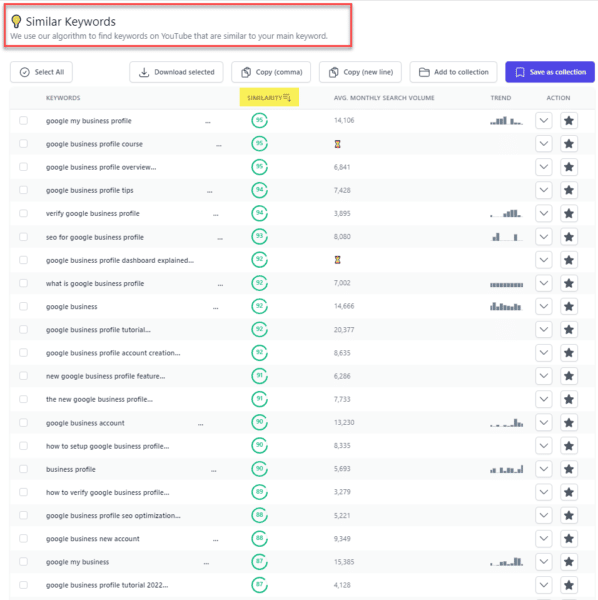
Another handy feature is the “Find Placement Videos” feature. When you click on this button under a keyword, a new window opens up showing the top-ranked videos for that keyword phrase.
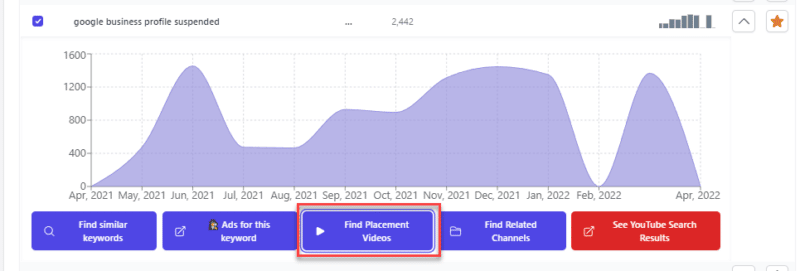
This information is invaluable because you can see:
- The videos ranking for the keyword phrase.
- The number of views each video received.
- Their video titles and a partial description of the videos.
All this without having to go to YouTube.
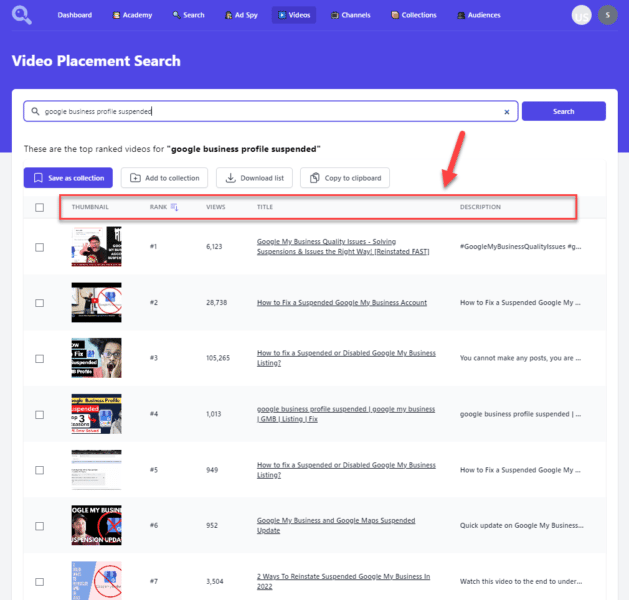
As an extra special bonus, clicking on the title link opens a pop-up where you can watch the video.
Keyword Search is one of my favorite YouTube keyword research tools by far. But there are other YouTube-specific software tools you should also check out.
vidIQ and TubeBuddy
Both used in the YouTube platform, vidIQ and TubeBuddy have a free version and several paid options. Each tool has pros and cons, so if you can afford it, I recommend you use them both.
TubeBuddy and vidIQ are great for finding the keywords – and related keywords – you should use to optimize your YouTube videos.
When looking at your high-ranking competitors’ videos, both tools show you keyword information that will help you determine what keywords you should target for your video.
For example, in our “how to make the best smash burger” example, vidIQ shows us the “top related opportunities” keywords you should consider targeting.
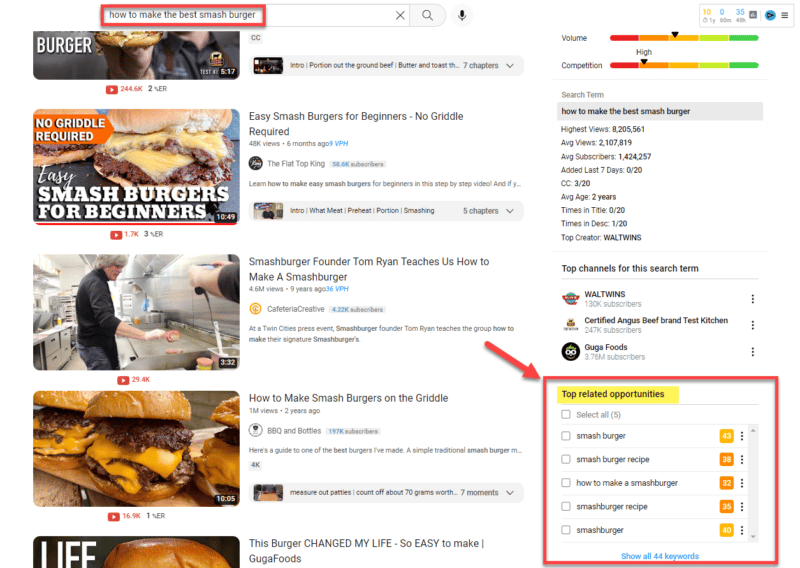
And if you click “Show all 44 keywords” you will get even more details about:
- The keywords you might want to work into your title, description and tags.
- Which keywords might be too competitive to target.
(As you can see, trying to rank for the keyword “smash burger” by itself is just too competitive at a High Competition score of 77.)
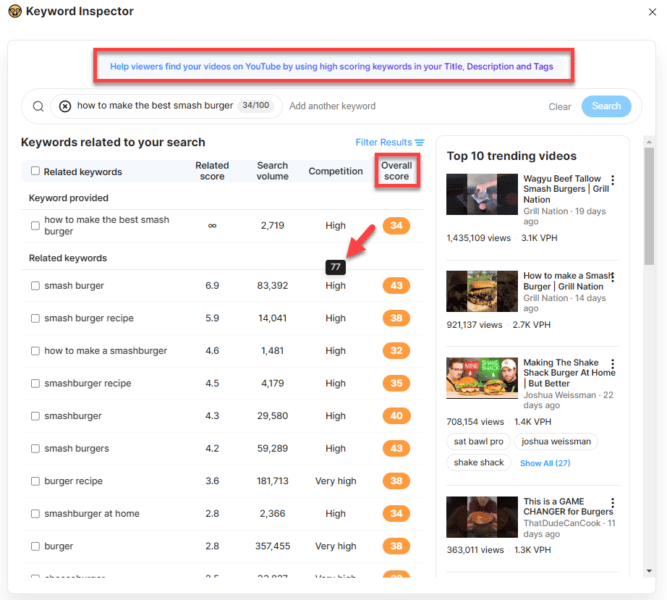
TubeBuddy also shows you related keyword search phrases and tags for your video keyword optimization strategy.
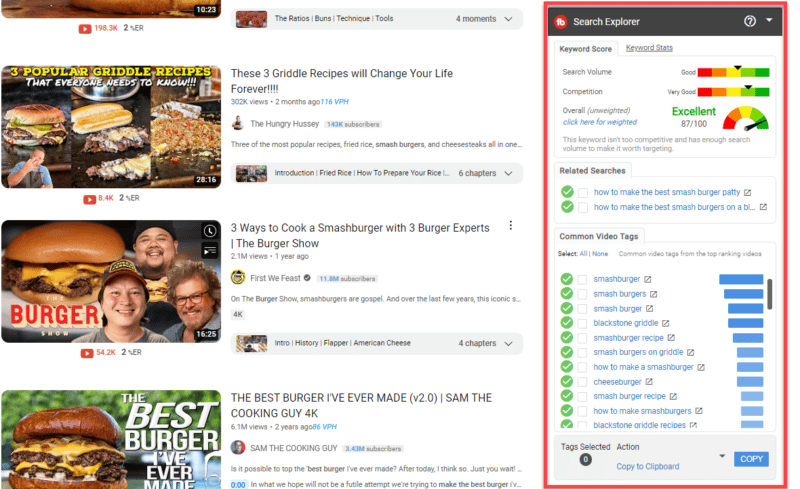
In vidIQ’s Keyword Inspector, you can:
- Enter keyword phrases you want to evaluate and see related keywords, the score, search volume, competition, and the top ten trending videos.
- Search up to five keywords at a time.
When determining which keywords to target, look for the high-scoring keywords.
In the example below, “Edit My Google Business Profile” had the highest score of 70/100:
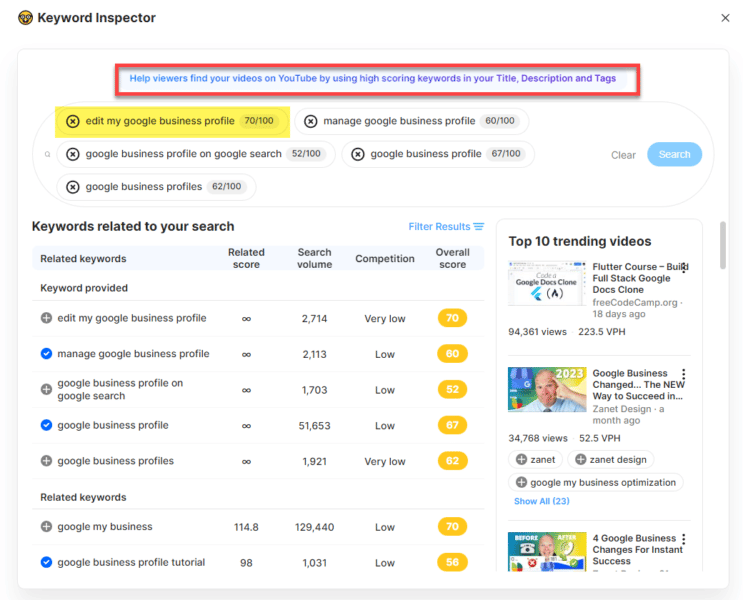
To test out this keyword strategy, I used that keyword phrase in the title of my recent Google Business Profile YouTube video:

Within three days, my Google Business Profile video ranked third for the keywords “how to edit my google business profile.” Boom!
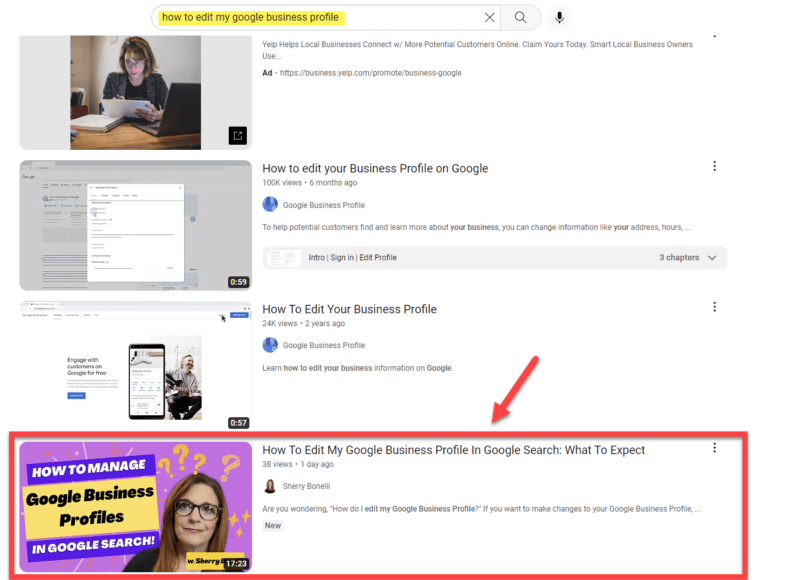
TubeBuddy also has a Keyword Explorer feature. When you start typing your keyword, TubeBuddy shows possible keywords you may be targeting.
Just continue entering your keyword phrase or select the one you’re interested in from the dropdown.
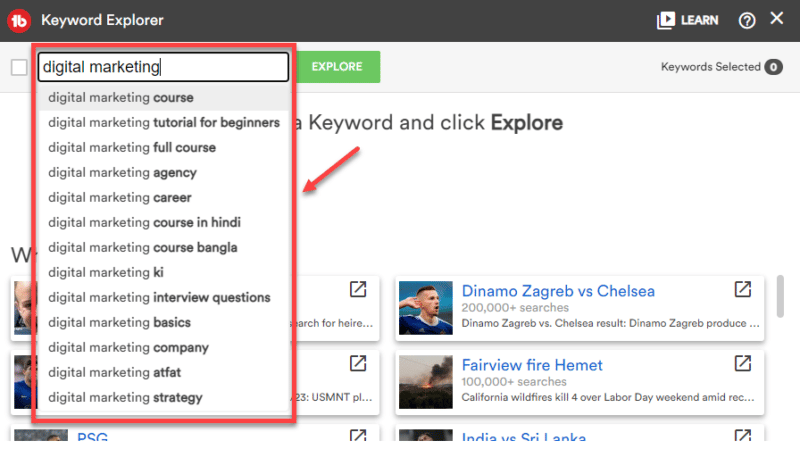
In TubeBuddy’s Summary page, ignore the overall score and focus more on the Score Analysis, Interest Over Time and Related Searches sections.
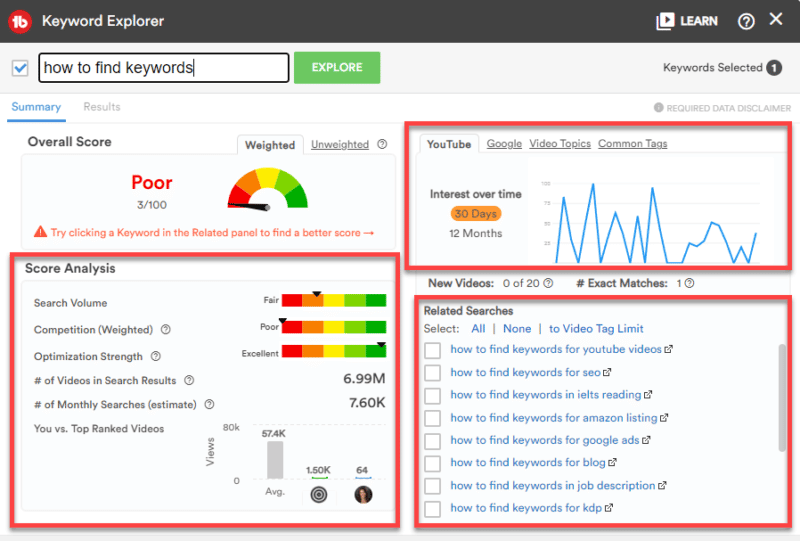
Let’s delve into TubeBuddy a little deeper.
When you look at YouTube search results for “How to Find Keywords for YouTube Videos,” you can see that there’s only one exact match in the top search results – and that happens to be Brian Dean’s video.

Clicking on Dean’s video, you can see TubeBuddy’s analysis of the video – which is quite extensive.
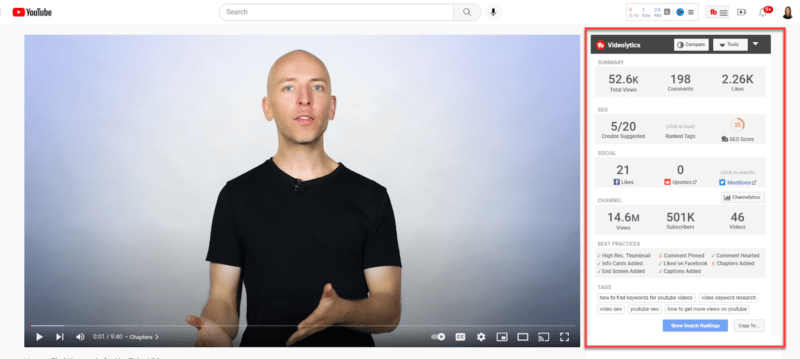
From this, you can see what his video is doing from a YouTube optimization perspective and what he’s missing so you can try and improve yours.
VidIQ also provides an extremely comprehensive analysis of the video.
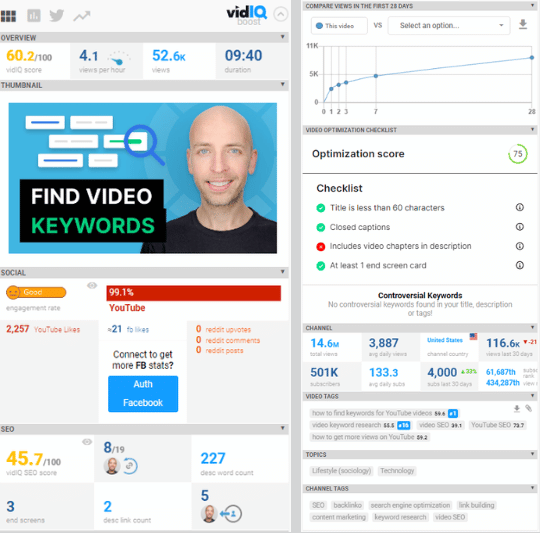
By using TubeBuddy or vidIQ (or both), you can:
- Find awesome keywords.
- Evaluate your competitors and their weaknesses.
- Capitalize on those flaws to make your video optimization stronger.
These tools go way beyond just keyword research, which will give your YouTube videos and channel a great advantage.
Where to put your keywords on YouTube for ultimate optimization
Once you find about 2-6 targeted keywords (and a few semantic keywords that complement those targeted keywords), it’s time to put those keywords to work in your video marketing.
Let’s talk about where you should strategically put your keyword phrases on YouTube.
Put keywords in your video’s title on YouTube
Your video’s YouTube title gives YouTube’s algorithm, users and search engines a “first impression” of your video and tells everyone what your video is about.
A well-optimized video title will make YouTube’s algorithm happy and attract more traffic, which can turn into more views.
When optimizing your title, include the most important keywords people are searching for as close to the front of your title as possible – this helps your video get ranked and suggested.
The keywords you most want to rank for should be included within the first 60 characters of your title. (Your title can be up to 100 characters, so the closer you put your keywords to the front of the title, the better.)
When writing your title, be as concise as possible. Five words or less is best.
If possible, use words in your title that connects the video to other videos in the same category.
Also, having a title that is catchy, compelling, and accurately represents the contents of your video can also help attract searchers. (No bait and switch, please.)
Strategically work keywords into your video’s description
With so many videos on the same topic, it’s often hard for your video to stand out.
Your video’s description is one way to make your video jump out among the crowd – and help your video rank.
Write a short – but detailed – description of what the video is about, what the watcher will learn and how your video is different or stands out from the other videos on the subject.
When it comes to keywords, putting the right keywords in your description will help your video get more views and visibility.
Remember that partial descriptions can also appear in search results, so be sure to put your keywords as close to the beginning of the description as possible.
That means:
- The main keywords you’re targeting should be within the first 200 characters of your description.
- The most important keywords should be in the first 25 words of the description because partial descriptions can appear in search results.
(Your video description can have 5,000 characters total. But if it is too long, it probably won’t be read in its entirety anyway.)
Throughout your description, it’s key to include partial matches of your targeted keywords in the description, too.
So write a description that is an overview of your video writing naturally using related and similar keywords to your targeted keywords.
That means breaking the words up, using semantic – or similar – keywords and using them individually in addition to the main target keywords you’re aiming for.
YouTube (and Google) use your text descriptions to determine the content of your video.
So if you don’t include a description, the search engines (and viewers) won’t know what your video is about. This will negatively impact your rankings.

In the description, you can also link to other related content you have (i.e., website, blog, social media channels, etc.). Remember to include your full URL (including the https:// or http://).
And if you’re at a loss for what to write, you can get a jumping-off point by using vidIQ’s AI Description Generator Feature.
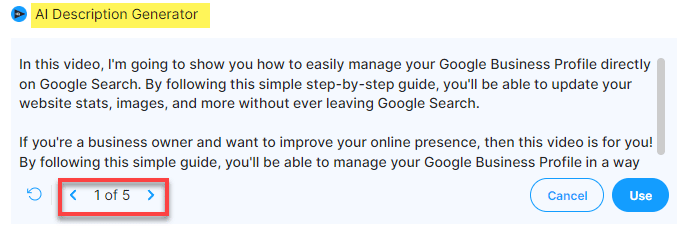
Hashtag it!
Many people like to search with hashtags. So for those people, adding appropriate hashtags in your description helps them find your videos when searching for specific hashtags.

Add a few appropriate hashtags to your description.
When you start typing in the hashtags, YouTube will show you the number of videos and channels that use each hashtag. That way, you can scope out your hashtag competition.

Ironically, no matter where you put hashtags in your description, the hashtags you entered show up directly under your video.

Keywords in tags: Do tags matter?
Tags can help categorize your video by keywords or phrases, but they’re primarily meant to help correct common spelling mistakes or synonyms (i.e., Google Business Profile vs. GBP or U-Haul vs. UHaul.)
Other than that, tags play a negligible role in helping people find your videos, according to YouTube. (Still, you want to include tags when optimizing your YouTube videos!)
YouTube allows you to include Tags to help categorize your video by keywords, but it limits the number of tags you can include. (There is a character limit of 500 characters.)
When you’re using tags, you should include your most important exact target keyword (or keyword phrase) as the first tag. That lets YouTube know what keyword phrase is the most important one.
It’s also recommended that you include partial matches of your target keyword as tags.
You’ll also want to include multiword tags (i.e., long-tail keywords) that relate to your video’s topic.
You should also use single-word and broad-term tags that relate to your video’s broader topic.
(Note: Do not use trademarks or copyrighted material unless you have explicit permission from the owner to use it.)
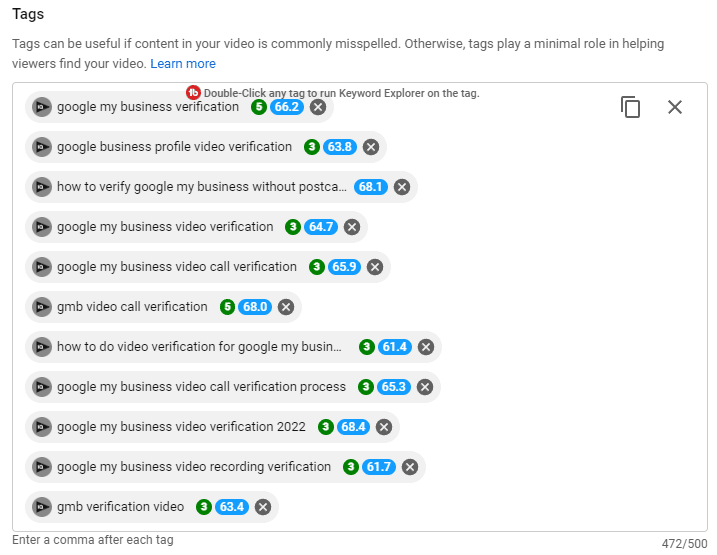
YouTube is effective at semantically understanding your tags – so you don’t need to go overboard.
One great way to get tag ideas is to look at the top-ranking YouTube videos that directly compete with your video. However, YouTube hides the video tags, which makes it more difficult to “spy” on your competitors and see their keyword/tag secret sauce.
Luckily, vidIQ and TubeBuddy lets you see the tags competitors are using to get their videos to rank high.
Get your video keyword and optimization strategy in place
By having a YouTube keyword research and optimization strategy in place, you can increase the chances of your videos showing up in YouTube’s search results.
Play your cards right, and you might even reach the top of Google search results.
Video marketing will continue to grow. Mastering YouTube’s ranking algorithm is a great way to kick your efforts into high gear.
The post YouTube SEO: How to find the best traffic-generating keywords appeared first on Search Engine Land.
source https://searchengineland.com/youtube-seo-find-traffic-generating-keywords-389947


0 Comments